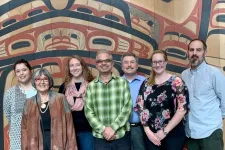(Press-News.org) As a result of the climate crisis, future forests may become unrecognizable. Trees that currently make up European woods may no longer be seen — or they may have moved several hundred meters uphill. Scientists writing in Frontiers in Forests and Global Change have mapped the forests of five vulnerable mountain areas in Italy and modelled the future of these fragile ecosystems.
“If I imagine my daughter walking with me as an old man, in our mountain forests, I can imagine that we can see the initial stage of a profound change of species,” said Dr Sergio Noce of the Euro-Mediterranean Center on Climate Change Foundation (CMCC). “Like any natural process, time is needed, and forests have times that are totally different from us.”
Seeing the wood for the trees
Forests provide valuable resources for communities. Wood products and wild foods like truffles may boost the local economy, while forests influence water availability and quality, create and preserve soil, maintain biodiversity, and offer recreation opportunities.
About a third of Italy is forested and wooded areas are currently increasing. However, in recent years, droughts, storms, and fires have damaged forests, driving rapid environmental changes. Mountain forests are especially vulnerable to the climate crisis.
To understand and react to what’s happening, we need high-resolution climate data and reliable models that can project forward into the future and try to understand the implications of the climate crisis for these precariously placed forests.
Noce and his team developed species distribution models of forests in five areas across the Apennines and the Alps. They combined them with projections of climate change based on two scenarios: one where emissions are moderated and one where nothing changes. Using this data, they developed maps of land suitability for future trees out to 2050.
“Knowing which species will be advantaged or disadvantaged in future conditions can help us in planning, management, and conservation choices,” said Noce. “The forest provides humans with very important ecosystem services - the regulation of the water cycle, the biodiversity, the wood and non-wood products, the tourism, the capture and storage of CO2 and many others. Every choice made today impacts these services for years to come and must be made with as much knowledge as possible.”
The forests of the future
Noce and his team found that most species saw their suitable range grow smaller, while some may extend beyond the current tree line and gain a larger range – notably the European larch and the Turkey oak. This was the case under both scenarios, although the degree of change differed: the scientists suggested considering these as the upper and lower bounds of possible outcomes.
In general, the tree line is likely to shift upwards, and species with smaller, more specific ranges are more likely to be lost. It is also possible that high mountain ecosystems like alpine meadows will become rarer, as trees encroach on current meadows.
The team said that it was difficult to identify obvious winners or losers among the tree species studied. However, they found that the silver fir and European beech are especially vulnerable. Of the five regions studied, the northern and north-eastern Apennines were at the greatest risk, with all present species of tree vulnerable to change. Mixed stands of trees incorporating diverse species were more resilient.
Turning over a new leaf
It is also possible that some survivor species will introduce other vulnerabilities. The Maritime pine, a candidate for bolstering forests in the southern Apennines, is more flammable than trees which are currently common there. As the risk of fire is expected to rise, this could create serious issues.
However, the authors cautioned that the relationship between environmental variables and species presence may not remain the same as in the past. Change could still surprise us. However, these high-quality models could help identify species and forests that could survive the climate crisis.
“We can consider this work as an experiment to be extended,” said Noce. “We already plan to deepen our research in Italy thanks to the European funds of the Next Generation EU program, but we plan to do so also by expanding the geographical extent and the time horizon.”
END
The climate crisis could reshape Italian mountain forests forever
Forests grow vulnerable as the climate crisis changes conditions in the Italian mountains
2023-09-08
ELSE PRESS RELEASES FROM THIS DATE:
Disney princesses can be good for a child’s self-image, UC Davis researchers suggest
2023-09-08
Children have loved Disney princesses since Snow White and the Seven Dwarfs premiered in theaters in 1937. While this adoration continues to grow in terms of princess movie ratings, some parents may wonder what effects these idealized images of young women might have on how their children feel about and express themselves.
According to new research from the University of California, Davis, a favorite princess improved — but did not harm — young children’s ...
University of Miami upgrades Atmospheric Chemistry Observatory in Barbados
2023-09-08
The observatory has been used to document the transport of Saharan dust particles across the Atlantic Ocean to the Caribbean, creating the longest-running dust data set in existence. Scientists from many different disciplines use the data to understand how dust particles impact everything from coral reef health to cloud formation and tropical storms.
Through a grant from the National Science Foundation (NSF), the University of Miami Rosenstiel School of Marine, Atmospheric, and Earth Science recently completed a major upgrade to its Barbados Atmospheric Chemistry Observatory (BACO), expanding its capability ...
Beaver activity in the Arctic increases emission of methane greenhouse gas
2023-09-08
The climate-driven advance of beavers into the Arctic tundra is causing the release of more methane — a greenhouse gas — into the atmosphere.
Beavers, as everyone knows, like to make dams. Those dams cause flooding, which inundates vegetation and turns Arctic streams and creeks into a series of ponds. Those beaver ponds and surrounding inundated vegetation can be devoid of oxygen and rich with organic sediment, which releases methane as the material decays.
Methane is also released when organics-rich permafrost thaws as the result of heat carried by the spreading water.
A study linking Arctic beavers to an increase in the release of methane was ...
Labour laws need updating now remote work is here to stay
2023-09-08
Australia’s employment laws and regulations must be updated to reflect the changing nature of work, with many people continuing to work from home long after the COVID-19 pandemic.
That’s according to University of South Australia Associate Professor of Organisational Behaviour Dr Ruchi Sinha who says labour laws and protections should be updated to clarify issues related to work hours, overtime, and breaks in a remote work context, now that almost half of all employees are working from home at least once a week.
The Australian Institute of Health and Welfare ...
UArizona scientists investigate new frontiers of sound with $30M center
2023-09-08
The National Science Foundation has granted the University of Arizona $30 million over five years to establish a new NSF Science and Technology Center. The New Frontiers of Sound Science and Technology Center, which comes with an additional $30 million funding option over the following five years, will bring together researchers working in topological acoustics.
With topological acoustics, researchers exploit the properties of sound in ways that could vastly improve computing, telecommunications and sensing. Applications could include reaching quantum-like computing speeds, reducing the power usage of smartphones, and sensing changes in aging infrastructure or the natural ...
Artificial intelligence could help build pollen jigsaw of present and ancient flora
2023-09-08
An emerging system which combines rapid imaging with artificial intelligence could help scientists build a comprehensive picture of present and historic environmental change – by swiftly and accurately analysing pollen.
Pollen grains from different plant species are unique and identifiable based on their shape. Analysing which pollen grains are captured in samples such as sediment cores from lakes helps scientists understand which plants were thriving at any given point in history, potentially dating back thousands to millions of years.
Up to now, scientists have manually ...
Distance from clinic influences abortion pill access
2023-09-08
Women who live farther from a medical clinic and those who identify as multiracial are more likely to use telemedicine to get abortion pills than to visit a clinic, according to a new study by researchers at the University of Washington School of Medicine.
The findings were published Sept. 1 in JAMA Network Open.
“One of the main takeaways,” said lead author Anna Fiastro, a family medicine research scientist at UW Medicine, “is that the further patients are from a brick-and-mortar clinic, the more ...
Study links epigenetic changes to historic trauma in Alaska Native communities
2023-09-08
CHAMPAIGN, Ill. — Researchers investigated the relationship between historical traumatic events experienced by Alaska Native communities and epigenetic markers on genes that previous studies have linked to trauma. The new study found a similar pattern among Alaska Native participants, with specific epigenetic differences observed in those who reported experiencing the most intense symptoms of distress when reflecting on historic losses.
The study also found that individuals who strongly identified with their Alaska Native heritage and participated in cultural activities generally reported better well-being. The new findings are detailed in the International ...
Mums exposed to air pollution give birth to smaller babies, but living in a greener area may mitigate the risks
2023-09-08
Milan, Italy: Women exposed to air pollution give birth to smaller babies, according to research that will be presented at the European Respiratory Society International Congress in Milan, Italy [1]. The research also shows that women living in greener areas give birth to bigger babies and this may help counteract the effects of pollution.
There is a strong relationship between birthweight and lung health, with low birthweight children facing a higher risk of asthma and higher rates of chronic obstructive ...
Stevens INI receives new funding to study small vessel disease in Asian Americans
2023-09-07
Asian Americans are among the fastest growing populations in the U.S. but are significantly underrepresented in Alzheimer’s disease and related dementias (ADRD) research. This means there is a significant knowledge gap of ADRD in this particular group at a time when the global Asian population is rapidly aging and the burden of ADRD will likely mirror this growth. Thanks to a new award, the Keck School of Medicine of USC’s Mark and Mary Stevens Neuroimaging and Informatics Institute (Stevens INI) is perfectly poised to help bridge the gap.
Professor of ...
LAST 30 PRESS RELEASES:
Whooping cough vaccination for pregnant women strengthens babies’ immune system
Dramatic decline in new cases of orphanhood in Uganda driven by HIV treatment and prevention programs
Stopping weight loss drugs linked to weight regain and reversal of heart health markers
Higher intake of food preservatives linked to increased cancer risk
Mass General Brigham–developed cholera vaccine completes phase 1 trial
First experimental validation of a “150-year-old chemical common sense” direct visualization of the molecular structural changes in the ultrafast anthracene [4+4] photocycloaddition reaction
Lack of support for people on weight loss drugs leaves them vulnerable to nutritional deficiencies, say experts
Dogs’ dinners can have greater climate impact than owners’
Are you ready to swap salmon for sprats and sardines?
1.6 million UK adults used weight loss drugs in past year
American College of Cardiology comments on new dietary guidelines for Americans
American Society of Gene & Cell Therapy and Orphan Therapeutics Accelerator partner to advance and commercialize promising rare disease treatments
One in 14 patients having day case surgery have new or worse chronic pain 3 months after their operation
New study highlights link between eviction rates and gun violence
Heatwaves heat up soil but not toxin levels in rice, study finds
Digital modeling reveals where construction carbon emissions really come from
Turning farm waste into water filters
New study shows how the spleen helps the immune system accept a transplant
New Mayo Clinic study advances personalized prostate cancer education with an EHR-integrated AI agent
Researchers identify novel therapeutic target to improve recovery after nerve injury
Microbes in breast milk help populate infant gut microbiomes
Reprogramming immunity to rewrite the story of Type 1 diabetes
New tool narrows the search for ideal material structures
Artificial saliva containing sugarcane protein helps protect the teeth of patients with head and neck cancer
Understanding the role of linear ubiquitination in T-tubule biogenesis
Researchers identify urban atmosphere as primary reservoir of microplastics
World’s oldest arrow poison – 60,000-year-old traces reveal early advanced hunting techniques
Bristol scientists discover early sponges were soft
New study uncovers how rice viruses manipulate plant defenses to protect insect vectors
NSF–DOE Vera C. Rubin Observatory spots record-breaking asteroid in pre-survey observations
[Press-News.org] The climate crisis could reshape Italian mountain forests foreverForests grow vulnerable as the climate crisis changes conditions in the Italian mountains





